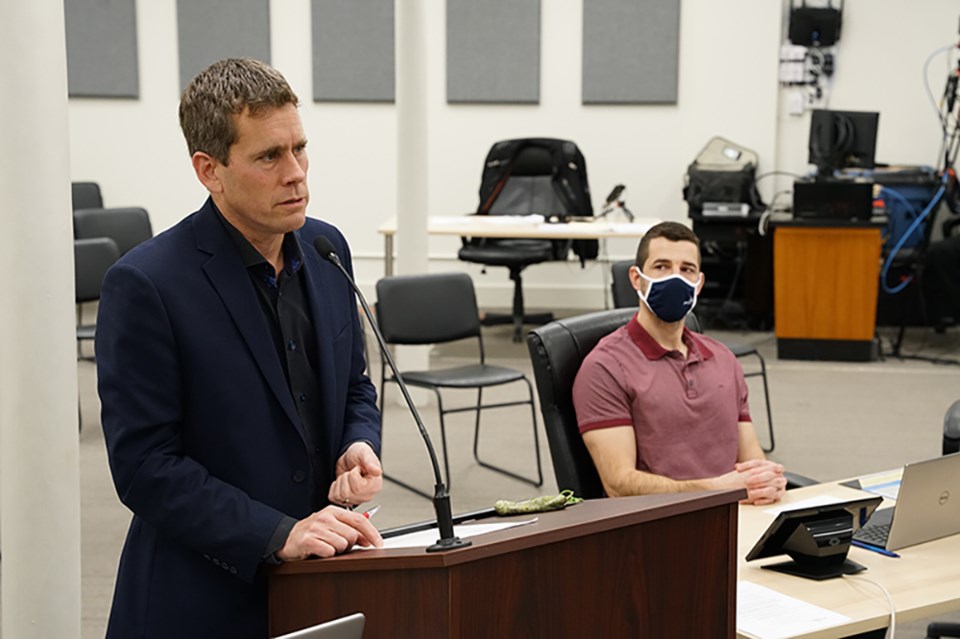Removal of city-owned property from the designation of mill industrial lands is a good measure, City of Powell River councillors were told.
At the December 14 committee of the whole meeting, chief administrative officer Russell Brewer said he wanted to provide an update on the request for partial removal of section 21.
“It has been a long desire on the part of city council and the community to get rid of section 21 from the Powell River Incorporation Act,” said Brewer.
“There was a staff report back in 2014 and a request was sent in to the minister. They responded with a letter that basically said any request needs to reflect the interests of first nations and stakeholders. At that time, they said hold off and see what the new council thinks about the section 21 request for removal or partial removal.
“For a number of reasons, it didn’t come forward at the subsequent council’s term, so staff brought back a report in June 2019 to consider again making a request for regulations to amend the fourth schedule, section 21, for partial removal.”
Brewer said the province advised the city, when staff followed up with them, that a legislative amendment would be required to amend the boundaries of the mill site area. He said the earliest an amendment could be considered was the fall of 2020. That was changed and delayed to the spring of 2021, largely due to COVID-19, and delayed again because there was an election in the interim, according to Brewer. He said it was finally introduced in October 2021. It was enacted on November 25.
“The Municipal Statute Amendment Act includes a section that allows for an amendment to the definition of mill site area that we have in our Powell River Incorporation Act, such that it’s now included in a regulation as opposed to the incorporation act itself,” said Brewer. “The definition of the mill site area will be in a regulation, so it makes it much easier to amend the regulation subsequently, rather than having to amend the act itself.”
Brewer said subsequent to the recommendation from 2014, the province also indicated that it wanted some ownership information in its direct interest in the properties, and also, information on who might have an indirect interest in the area and their views on the proposed changes. He said that in early 2020, a request for the proposed amendment was submitted to the province, along with copies of letters that were sent to Tla’amin Nation, qathet Regional District, a number of stakeholders, as well as any entities that either owned property that was subject to section 21 or had a form of tenure within the area subject to section 21.
Brewer said the new boundaries reflect properties owned by Tla’amin Nation, Western Forest Products (WFP) and Catalyst Paper Tis’kwat. He said the boundaries reflect engagement with Tla’amin together with WFP and Catalyst, and that they wanted some areas to remain as section 21.
“We’re not adding any areas to be covered by section 21,” said Brewer. “This amendment in regulation is going to remove areas from section 21. Surprisingly, it runs all the way from our Willingdon Beach area, through to the haul road, and the large part of the city’s property around the consolidated wastewater treatment plant area, and also our barge terminal facility.
“Western and Tla’amin both wanted to retain section 21 over their properties because through discussions with Catalyst, they wanted to ensure there was a direct route for fibre delivery to the mill. That includes the two log dumps and the property where our treatment plant is situated. Originally, the map showed the treatment property being removed from section 21, but that’s one large lot that runs right down to the water. It couldn’t be done without subdividing the property, which comes with a whole bunch of other headaches.”
Brewer said with regard to the Tla’amin property, when it is converted to treaty settlement land, it will be removed from section 21.
“So really, the change is through discussions with Catalyst, Western and Tla’amin to retain, from their perspective, some certainty on the direct delivery of fibre to the Catalyst mill,” said Brewer. “Obviously, since the enactment in November, Catalyst Paper made the announcement about the mill curtailment. We could reconsider a request for amendment to section 21 if we wish to do something different given the mill announcement. However, the province said it would restart the whole submission process, which council could consider doing. The suggestion was that given the regulation is nearing completion, and it’s a couple months away, it’s a much easier process to amend the regulation.”
Committee chair and councillor Cindy Elliott asked given that the mill is indefinitely closed, was there a way to remove section 21 from those lands?
Brewer said it would be a request of council to the province to remove section 21 entirely. He said once section 21 has been moved into regulation, council could follow up at any time to request a further amendment to the regulation, to redefine boundaries or remove it entirely.
Councillor George Doubt said what he was taking away from Brewer’s report is that the city was generally successful in its application to remove city-owned lands from section 21 so that it would have more planning control over what takes place on those lands.
“It enhances what we would have had if section 21 still applied to them,” said Doubt.
Brewer said it gives the community more certainty over the city-owned lands.
Doubt said good things have been achieved for the future planning of Powell River.
“This is positive,” said Brewer. “A lot of land has been removed from being subject to section 21. I want to point out we’re not adding any lands to section 21.”



